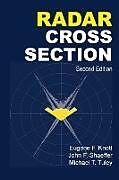Radar Cross Section
Einband:
Kartonierter Einband
EAN:
9781891121258
Untertitel:
Englisch
Genre:
Luft- und Raumfahrttechnik
Autor:
Eugene F. Knott, John F. Schaeffer, Michael T. Tulley
Herausgeber:
Institution of Engineering & Technology
Auflage:
2. Auflage
Anzahl Seiten:
626
Erscheinungsdatum:
01.06.2004
ISBN:
978-1-891121-25-8
Autorentext
Eugene F. Knott received his MS in Electrical Engineering from the University of Michigan in 1966. He spent 16 years at the University of Michigan Radiation Laboratory conducting RCS measurements of lab models and developing prediction models and moved on to the Georgia Institute of Technology extending similar models and conducting feasibility programs. His entire career has been spent in RCS-related programs.
Klappentext
Radar cross section (RCS) is a comparison of two radar signal strengths. One is the strength of the radar beam sweeping over a target, the other is the strength of the reflected echo sensed by the receiver. This book shows how the RCS gauge can be predicted for theoretical objects and how it can be measured for real targets. Predicting RCS is not easy, even for simple objects like spheres or cylinders, but this book explains the two exact forms of theory so well that even a novice will understand enough to make close predictions. Weapons systems developers are keenly interested in reducing the RCS of their platforms. The two most practical ways to reduce RCS are shaping and absorption. This book explains both in great detail, especially in the design, evaluation, and selection of radar absorbers. There is also great detail on the design and employment of indoor and outdoor test ranges for scale models or for full-scale targets (such as aircraft). In essence, this book covers everything you need to know about RCS, from what it is, how to predict and measure, and how to test targets (indoors and out), and how to beat it.
Inhalt
Chapter 1: Introduction Chapter 2: Radar Fundamentals Chapter 3: Physics and Overview of Electromagnetic Scattering Chapter 4: Exact Prediction Techniques Chapter 5: High-Frequency RCS Prediction Techniques Chapter 6: Phenomenological Examples of Radar Cross Section Chapter 7: Radar Cross Section Reduction Chapter 8: Radar Absorbing Materials Chapter 9: Radar Absorber Measurement Techniques Chapter 10: Antenna RCS and RCSR Chapter 11: RCS Measurement Requirements Chapter 12: Outdoor RCS Test Ranges Chapter 13: Indoor RCS Ranges Chapter 14: Hip-Pocket RCS Estimation, Data Presentation, and Reduction

Leider konnten wir für diesen Artikel keine Preise ermitteln ...
billigbuch.ch sucht jetzt für Sie die besten Angebote ...
Die aktuellen Verkaufspreise von 6 Onlineshops werden in Realtime abgefragt.
Sie können das gewünschte Produkt anschliessend direkt beim Anbieter Ihrer Wahl bestellen.
Loading...
Die aktuellen Verkaufspreise von 6 Onlineshops werden in Realtime abgefragt.
Sie können das gewünschte Produkt anschliessend direkt beim Anbieter Ihrer Wahl bestellen.
| # | Onlineshop | Preis CHF | Versand CHF | Total CHF | ||
|---|---|---|---|---|---|---|
| 1 | Seller | 0.00 | 0.00 | 0.00 |
